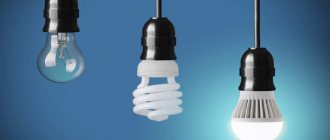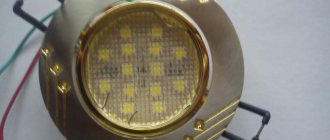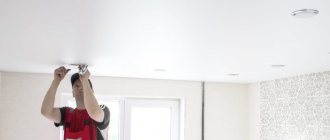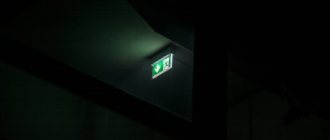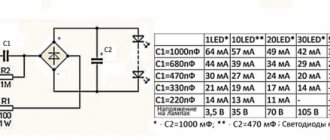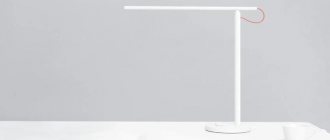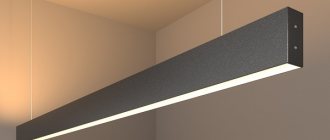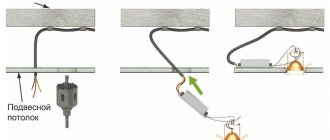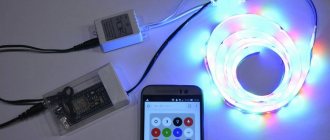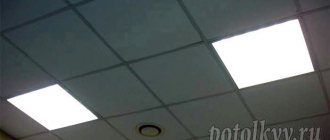Sooner or later, home renovations come to the stage when it is necessary to install lamps in drywall. The installation process does not require any special skills. Moreover, with rare exceptions, most models of lamps for plasterboard ceilings are equipped with special fasteners and mounting devices. The worker will only need to carefully prepare the holes and fasteners, connect the wiring and install the product into the hole in the drywall.
Features of recessed luminaires for plasterboard ceilings
The main distinguishing feature of the ceiling lantern is the simplicity of its design. The number of operations required to install luminaires in a plasterboard ceiling is reduced to a minimum. But you shouldn’t expect an easy solution to the problem; often, flashlights and lighting elements purchased at a showroom can be fraught with unpleasant surprises.
Electricians installing built-in lamps in drywall recommend paying attention to the following nuances:
- A huge number of different models of LED and halogen light sources are produced around the world, designed for installation specifically on drywall. Moreover, most of the models are manufactured using an open design. This means that the lamp has a front panel, a reflector and a housing frame on which the remaining parts are held. Almost always, the manufacturer saves on clamps, so you need to be prepared for the fact that the plastic spring or clamp securing the lamp to the drywall will break during the first installation attempt;
- Most lighting devices are produced according to standard mounting dimensions of the housing and terminal connectors for connecting wiring. If you buy a flashlight from a well-known brand or manufacturer, then, as a rule, there are no problems. On the other hand, cheaper models of lamps, especially those made in China, can “please” during installation with non-standard shapes and sizes, a falling off reflector or the absence of a fastening spring.
Advice! It is better to buy beautiful spotlights for plasterboard ceilings together with a specialist who can select the highest quality products, and at the same time recommend one or another model for installation, depending on the interior and the conditions for organizing the lighting of the room.
The advantage and at the same time disadvantage of modern built-in lamps is the reduced supply voltage. On the one hand, this is safe, on the other hand, it means that, in addition to the lantern body itself, it will be necessary to place an additional power supply or step-down transformer in the space between the rough ceiling and the drywall. This is a small unit, slightly larger than a phone charger, but it will also need to be secured, and sometimes additionally covered from condensation or accidental damage during installation.
When choosing a lamp model, you need to take into account the maintainability of the design. Installation conditions must ensure trouble-free removal of the entire lamp or luminaire with drywall without damage.
How does the frame affect the height of the ceiling structure?
A reliable frame made of metal profiles is the basis of the suspended ceiling. It performs three functions:
- with its help they create multi-tiered structures;
- it serves as the basis to which the fastening elements of the tension fabric (mounting strips) are fixed;
- performs a camouflage role and additionally holds pipes, hoods, electrical wiring, etc.
The frame is made of various materials, the type of which also affects the ceiling level. The use of a metal-plastic profile will take 13-15 cm from the height of the room, so it is used only in large-sized office or industrial premises where it is necessary to strengthen the load-bearing capacity of the stretch ceiling.
Preparing a metal frame for a suspended ceiling
Types of spotlights for drywall
Typically, four types of light sources are used to organize lighting:
- Halogen lamps;
- LED assemblies;
- Classic incandescent light bulb;
- Fluorescent lamps.
A conventional incandescent lamp is rarely used in plasterboard ceilings due to its low light output and short lifespan. Demand for fluorescent or energy-saving light bulbs is also declining due to high sensitivity to voltage changes. In addition, older lamp models widely use mercury compounds, so it is better not to use this type on drywall in residential areas.
Installing spotlights in drywall turns out to be simpler and more affordable than choosing a built-in model that matches the interior and furnishings. Typically, more modern LED and halogen devices are used for plasterboard ceilings; they are more durable, although they are more expensive.
If the customer prefers halogen lamps, then the installation will need to additionally check the cross-section and quality of the wiring, as well as the absence of fusible materials in the finishing of the ceiling surface.
With high light output, halogen ceiling lamps built into a plasterboard structure can overheat in the absence of free air space and cause the reflector to melt.
Based on the body design, spotlights are divided into three categories:
- Ordinary, with an open back and a stationary reflector. Installation of such a lamp is carried out by fixing it into a hole in the drywall, after which the lamp can only shine in one direction;
- Rotating or adjustable model. In fact, this is a variation of the previous version, in which the reflector is made on a rotating hinge. It can deviate together with the light source at a small angle, up to 45o;
- The protected version of the lamp is a sealed housing, inside of which a light source, a reflector and a contact group for connecting electrical wiring are mounted.
Waterproof models are usually installed in bathrooms and rooms with high humidity. Installing this type of lamp on drywall in a living room or even in a kitchen does not make sense; they cost more, and there are no special advantages in terms of resource or decorative design.
The protected design is convenient in that the lamp will not fail even if water leaks through the ceiling onto the drywall. It is clear that if there is a risk of flooding, then the location and location for installation must be chosen taking into account the possible consequences. But repairing a waterproof spotlight is quite difficult; it is not enough to remove the housing from the drywall; this is the simplest stage of repair. You also need to properly disassemble the device in order to get to the light bulb and, preferably, without damaging the seal.
Unfortunately, most manufacturers make protected models that can only be disassembled a couple of times, after which you have to look for ways to replace the seals, including using sealant and fum tape.
Lamps with a movable reflector are convenient because you can always adjust the direction of the light flow relative to the vertical axis; the maximum reflector can deviate by an angle of up to 45°. But there is one obstacle: installing an LED lamp on a plasterboard ceiling makes it not very convenient to control the adjustable reflector, it is too high.
In addition, 3-5 months after installing the lighting on the ceiling, the body and fittings of the lamp become clogged with dust, so it becomes difficult to turn the reflector. Therefore, after installation, such models are immediately set in the required direction and fixed so that there is no need to return to adjustments.
Repairing such devices is quite simple, but there is one limitation. In addition to the electrical part, the housing must contain polypropylene inserts, therefore, if you install a halogen lamp instead of an LED one, then after 5-6 months the inserts are tightly welded to the base, and accordingly, it will be almost impossible to disassemble the flashlight. All that remains is to replace the halogen lamp with a more gentle LED bulb and repeat the installation on the ceiling, turning the reflector in the desired direction.
Stationary built-in lamps are convenient in everything. They are lightweight and most of the structure is open for cleaning and maintenance. In addition, the absence of an external housing facilitates and improves the cooling of the reflector, so in this design it is quite possible to install both conventional incandescent lamps and halogen light sources.
Popular lighting schemes or calculations when combining lamps
To correctly calculate the number of devices for combined lighting, their total power is calculated. The calculation is made using the same formula. However, in the end the amount is not divided by the number of lamps of the same type.
First you need to decide on the lighting scheme. Once its components have been selected, the power of each lamp individually can be subtracted from the sum. Or subtract the power of a lamp of one type, and then divide the remainder by the number of devices of the same type.
The most popular solution is to place the main lamp in the center. The remaining lamps are placed, advantageously zoning the space:
Chandelier and spotlights
This scheme looks good in the kitchen. The chandelier is placed above the dining table so that its light evenly covers its space. Spotlights are placed in the work area.
In the living room, a chandelier is often mounted in the center, and additional lamps are placed into the room, making up some kind of geometric figure.
The number of spotlights is calculated after the watts allocated to the chandelier are subtracted from the total power.
Spots and lighting
Directional lighting should be placed in work rooms. For example, in offices or near the kitchen work area.
Spotlights and LED strip
When installing such a circuit, it is appropriate to place the LED strip above the place where people will spend more time. Spotlights should be placed at the other end of the room. You can also use them to replace a chandelier. It looks good both in rooms with a small area and in spacious rooms.
Chandelier and lighting
The chandelier and lighting will perfectly complement each other, dividing the room into zones. Lighting plays a decorative role, creating accents. Or, on the contrary, it improves the lighting above the desktop or gaming space.
Which lamps are best for drywall?
Despite all the advantages of the LED circuit, it is impossible to say unequivocally that this particular option is best suited for installation on the ceiling. The optimal choice of a particular model and light source depends on the shape and size of the plasterboard ceiling structure, as well as the overall interior of the room.
LEDs on the ceiling
Today, LED ceiling lights for plasterboard are considered the best in efficiency and reliability. The very bright and at the same time cold bluish-gray glow from a spotlight LED lamp is not entirely suitable for lighting a room in dark blue, black and red tones, or any darkened rooms.
Spotlights with LEDs are ideal for light multi-tiered plasterboard ceilings.
Halogen
If built-in ceiling lights are the main source of light in the room, and in addition, you need not a monochrome, but a full-fledged flux, not inferior to that of the sun, then the best option would be halogen LED lamps for drywall.
Ideal for colored and monotonous ceiling cladding. The only limitation is the high power of the lamps, therefore, if you are installing drywall with a tension sheet, you will need to increase the distance between the plastic and the lamp, otherwise the plastic will gradually melt.
Incandescent lamps
It may be perceived as an anachronism, but it is lanterns with incandescent bulbs that create a stream of light that does not irritate the human eye. Such lighting is inferior in brightness to LED, but the filament, like halogen, provides a wide spectrum. Therefore, the installation of such spotlights in plasterboard is carried out in places where lighting is needed, for example, above a chair near the TV or above a computer screen, on the ceiling in the corridor.
Additional Selection Considerations
When choosing spot lighting products for various types of floors (made of plasterboard, suspended or tensioned), you must, first of all, rely on the type of socket design the device has. The type of socket will determine the size of the light bulb that needs to be screwed into the socket. And the depth at which the device will be placed directly depends on this (if a built-in type is used).
Light bulb socket
Such devices have cartridges:
- E27 – designed for a standard light bulb, so it’s quite large;
- E14 - “minion”. Quite small;
- G4, G5, G9 – these bulbs have pins, which allows them to reduce overall dimensions.
As you can see, the standard sizes of cartridges have a direct impact on the dimensions of point models. We've sorted out the range of product choices. Now let's look at what devices need to be used in each individual case.
Arrangement options for LED spotlights for plasterboard ceilings
The installation scheme and placement of lighting points on plasterboard depends only on the design of the ceiling. This could be installing lamps in a chain around the perimeter of the room. For such a scheme, stationary unregulated lamps are used.
A fairly popular scheme is in which the ceiling lights are distributed in several groups. In this case, the main part of the light flux is directed not vertically, but at an angle towards the wall.
This is called reflected flux lighting. Very convenient if you need to create an atmosphere of comfort in the room.
Adjustable lamps with LED reflectors are installed in the kitchen and auxiliary rooms. They are most convenient for conditions where they work and require high brightness lighting.
What to pay attention to when installing
It is necessary to study and take into account important points, without which successful installation of lighting equipment is impossible.
For example:
- For narrow rooms, it is better to arrange the system in 2 rows - this technique will visually expand the room;
- Decide which areas should be highlighted in multifunctional rooms;
- Will the lighting be main or additional;
- Where are the kitchen work and dining areas, mirrors, reading or working areas that require brighter light;
- If the housing is not compact, take into account the distance from the tension fabric to the ceiling partition. Normally no less than 8 cm;
- Built-in or surface-mounted equipment using incandescent lamps can damage the ceiling fabric. Up to 40 degrees C – permissible heating limit;
- The desired distance between light points is at least half a meter;
- The color and appearance should harmoniously complement the interior design.
In each installation case, individual nuances arise. Taking into account the features and following the instructions, you will correctly install the main lighting or supplement it.
Dimensions of spotlights for plasterboard ceilings
For home lighting, devices with a reflector rim diameter of 85 mm and 106 mm are used. The first type is used for LEDs, halogens and incandescent lamps designed for open-frame installation. The height of the housing can vary from 35-45 cm for LED models, up to 60 mm for halogen and 90 mm for incandescent bulbs.
A larger diameter of spotlights for drywall is used in situations where a fluorescent lamp is used as a light source. They have lower luminous flux density and intensity, so you have to use a larger reflector size so as not to increase the number of lighting points on the drywall. The case height is one of the largest, up to 95 mm.
Technical advantages
A large selection of spot lighting characteristics provides a variety of functional features. But its positive qualities, first of all, depend on the quality of the device and its configuration:
- The presence of a uniform wide angle of illumination and the ability to control it;
- Safety in high humidity;
- Protection from dust, vibration, mechanical damage;
- Low power consumption;
- Remote control, which is convenient for high ceilings;
- Increased service life;
- Possibility of using different lamps;
- No noise, flicker or glare;
- Compact and aesthetically appealing.
Each user will find other additional benefits for themselves.
Diameter of the hole for a spotlight in plasterboard
For the vast majority of models, the case size is either 60 mm or 75 mm. But this is precisely the mounting dimension, which is measured not by the rim of the reflector cover, but by the distance between the clamps when folded.
In addition, the round shape of the reflector does not mean that it is necessary to drill a round hole to mount the device on drywall. There are many models, as a rule, these are lamps with built-in motion sensors, in which a hole for installation must be cut in a square or rectangular shape.
Halogen
In essence, these are the same incandescent light bulbs, but thanks to special additives - halogens - they work longer (average life is about 3,000 hours). The emission spectrum of halogen light sources is less yellow and resembles daylight. Halogen lamps are somewhat more expensive than conventional incandescent lamps, and during operation the bulb of the device heats up to a high temperature (250 degrees Celsius or more). This must be taken into account when designing lighting so that a very hot lamp does not start a fire. And drywall does not like local overheating. As for energy efficiency, due to the higher heating temperature of the spiral, halogen sources are somewhat more economical than conventional Ilyich light bulbs.
LED
Today it is the most effective and promising light source. LED lamps heat up slightly (40-60 degrees Celsius), are compact and allow you to obtain lighting of almost any color temperature (shade) - from yellowish “warm” to bluish “cold”. The light output of semiconductor light bulbs is approximately 8 times higher than the light output of incandescent lamps. The main disadvantage of diode designs can be considered their high cost, which, however, is compensated by a long service life (up to 30,000 hours or more).
How to install spotlights in drywall with your own hands
To install a spot lighting device you will need:
- Core drill with centering tool;
- Drill or screwdriver;
- Wiring with a cross section of 1.5 mm2.
You will definitely need to stock up on a construction knife, a screwdriver and pliers. Despite the fact that most models of recessed flashlights are designed to be installed into a hole without any tools, in about half of the cases, installing a spotlight in a plasterboard ceiling is done using a screwdriver and pliers.
How to wire spotlights under drywall
First of all, you need to select a connection diagram and mark the installation points. If it is planned to divide all the lights into two groups, then you will need to purchase two mounting junction boxes and a wire, preferably brand VVG-3x1.5 or ShVVP.
We measure the amount of wire so that each lamp is connected to its own box with a separate wire. Plus another 20 cm at each point to simplify installation and wiring.
For your information! All wiring from the junction box to the connection point must be in bundles.
How to make a hole in drywall for a light fixture
To pierce a plasterboard sheet, we use a tubular core drill bit. In order for the light to hold securely, the hole in the plasterboard for the light must be exactly 60mm, so the drill should be 59.5mm or 59mm, depending on the thickness of the material.
Before starting drilling, it is advisable to make a centering hole at the point with a small diameter drill, 2-3 mm. This will help you cut the hole in the ceiling sheet more accurately.
If while working with a drill and screwdriver your hand trembles and the tool moves slightly to the side, you can correct the situation with a knife. You need to carefully align the edges without expanding the diameter of the hole; this will help you install it exactly into the seat.
How to fix a lamp on drywall
Before installation, we clean the ends of the wiring and insert them into the contact clamps. Typically, the length of the wiring is selected so that the connected flashlight hangs on the wire at a distance of 15-20 cm from the drywall.
It is clear that after connecting, you need to check the functionality of the device by plugging it into the network for a few seconds.
Next, you need to compress the spring antennae on the body and insert the flashlight into the prepared hole. The springs straighten and securely press the device to the drywall. In order not to cut the ceiling material, it is recommended to align the lantern in the desired direction until the spring clamp is completely released.
Supply voltage
Bulbs used in ceiling spotlights can have different operating voltages, both alternating and direct. Incandescent lamps usually require an energy source of 220 V and much less often 24 or 12 V. Such lamps can be powered by alternating or direct current. The same applies to halogen lamps, but low-voltage versions are much more common. Conventional 220 V lamps are convenient because they do not require additional power supply equipment, and the electrical circuit for their installation is extremely simple. If the choice fell on low-voltage lamps, then you will have to acquire a step-down transformer (converter) for the appropriate voltage. You will need one, but its power should be enough to power all the lamps.
The situation is somewhat different with LED lighting and ceiling lighting devices. A light-emitting diode is a polar device, which means that it requires a small constant voltage. Some semiconductor lamps have a built-in power supply (driver), which not only provides the LEDs with the necessary power, but also acts as protection for the lamp from power surges. Connecting such a device does not cause problems; it can operate from a regular 220 V network. But there are often spotlights for ceilings that do not have a driver. In this case, you will have to purchase an additional driver with the voltage for which the lamps are designed, and the power of this driver should be enough to power all the lamps.
How to remove a spotlight from drywall
The outer cover in the form of a ring is attached to the body using protrusions on the inside. Therefore, if necessary, you can separate the part from the reflector and insert it into the hole without a housing. To install the lamp, the reflector with the light bulb is inserted inside the cover and rotated in a horizontal plane at a small angle.
To dismantle the lamp, the procedure is performed in the reverse order - rotate the housing with the reflector, take them out, after which you can replace the lamp, remove the device or perform reverse installation.
What do security numbers mean?
Standard models provide a regulated protection indicator - it is indicated by the abbreviation IP. The two numbers next to it indicate:
- The first is to protect against clogging of the structure with solid particles. 0 – no protection. From 1 to 4 – possible ingress of particles (in descending order of their size). 5 – the structure is completely protected from the penetration of dust grains;
- The second is the degree of protection against moisture. From 0 to 8, where 0 means there is no protection from moisture, and 8 means it can withstand prolonged immersion in water.
Review of popular manufacturers
The range of spotlights on the market is quite wide. Dozens of factories present their products. Let's look at the most famous ones.
Ecola
A company from China presents unique lamps that use about 7% of electricity compared to conventional incandescent devices. The service life of the products is 5-10 years.
Ecola specializes in luminaires for suspended ceilings, including the GX53 with a thickness of 27 mm. The H4 model of this type is available in nine colors. One of its advantages is the metal eyelet to which the spring is connected. In the similar H6 model, everything is made of plastic. This material ages, so over time the fasteners break and the lamp is held in the air only by the electrical wiring. The company also produces reflex devices. One of the unique new products is a lamp with a key, which cannot be unscrewed from the base without authorization.
Philips
The Dutch company has also succeeded in this field, having founded the Signify trademark. Under this name, universal and reliable lighting devices are produced. Many are compatible with suspended ceilings - for example, Probos spotlights. One of the distinctive features of the Signify brand is its stylish European design, which gives the interior a special charm.
Gauss
Spotlights from this brand are made in Germany, a country that is famous for its scrupulousness, punctuality and accuracy. There are solutions for different interiors. Thus, the discreet Aluminum and Tablet lines will fit perfectly into the high-tech style. Gypsum are designed more for the “classics”. Brilliance and Crystal products create interesting reflections on a glossy surface.
Citilux
The Danish brand, founded in 1944, creates household lighting “for a beautiful and comfortable life.” Its products are recognizable by their ease of use, light and elegant design, characteristic of the Scandinavian style. The devices are resistant to moisture, temperature fluctuations, and vibrations. The main part of the range is presented in an affordable price category. For suspended ceilings, Citilux produces lines of spotlights “Alpha”, “Beta” and “Luna”.
Feron
This is another Chinese manufacturer on the Russian market. There is also plenty to choose from. Almost all types of spotlights are manufactured for suspended ceilings - LED, waterproof, crystal, built-in, overhead, etc. The brand presents its products in the budget price category.
Navigator
The plant, located in Klin, Moscow region, is equipped with the latest technology. Advanced technologies have been introduced into production, allowing us to produce products that can be put on par with imported analogues. The brand offers modern devices - LED panels, built-in and surface-mounted spots and lamps.
Some tips for use and care
- It is necessary to periodically clean the devices from dust and check the integrity of the electrical wiring.
- Make sure that the devices are not exposed to water.
- If the lights stop working, check the transformer. In most cases, the reason is its overheating and protective disconnection from the network.
- Flickering of lamps may be due to the use of a backlit switch. You can replace the switch or replace the first leg in the circuit with an incandescent lamp.
- If the lamp housing melts or cracks, the lamp type must be replaced.
Advice! No abrasive powders or chemical solvents are used for cleaning.
Bottom line
Spot lighting is a stylish solution for interior decoration. They help emphasize the design and allow you to visually change the space.
Installation of lamps does not require any special skills and can be done on your own
The only thing to remember is that all connections must be protected as much as possible, and the wiring itself is securely hidden in a special corrugated pipe that does not support combustion.
